When a water heater backdrafts, it’s a safety hazard. Homeowners usually don’t know they have a problem because a backdrafting water heater will almost never set off a carbon monoxide alarm. A water heater backdrafts when the exhaust gases from an atmospherically vented water heater spill out into the room, rather than safely leaving the house through the vent. Exhaust gases contain carbon monoxide and high levels of moisture, so this is always a condition that should be corrected.
An atmospherically vented water heater is a type with a draft hood, which relies on gravity to get the exhaust gases out of the home. Exhaust gas is hot and therefore lighter than the surrounding air, which is what allows it to rise up the vent and out of the house. These are very simple devices that require no electricity to operate, however, this isn’t a very reliable draft method. Today I’m going to share some clues that could indicate a problem with a water heater drafting properly.
MELTED PLASTIC AT THE DRAFT HOOD.
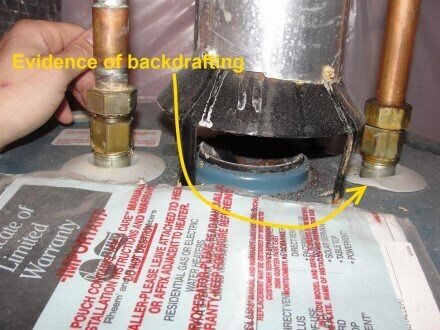
When the plastic at the top of a water heater is melted, it’s pretty much a guarantee that the water heater has backdrafted. I’ve heard some folks claim that the plastic melted when the water heater was installed because someone got too close to the plastic with a torch while soldering the pipes. That’s possible if the solder joints are very close to the water heater tank but very unlikely. Especially when the part that’s most melted faces the draft hood.
CORROSION AT THE TOP OF THE TANK
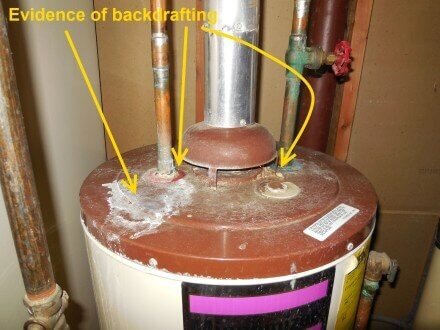
Backdrafting exhaust gases can condense at the top of the water heater tank. Over time, this corrosive condensate will begin to corrode the top of the tank. A leaking shutoff valve can also cause corrosion at the top of the tank, but that type of corrosion is easily distinguishable back corrosion caused by backdrafting because the worst area will be located directly below a valve.
MOISTURE AT THE TOP OF THE TANK
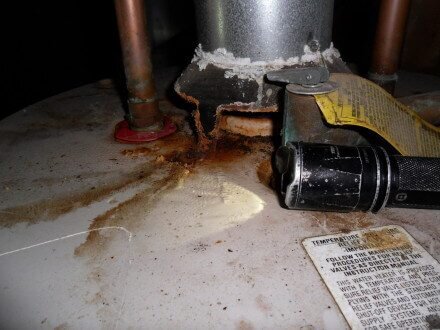
If you can see condensation at the top of a water heater tank, you’re basically watching the water heater backdraft. The photo below shows moisture, rust, and melted plastic at the top of the water heater. Click the photo to see a large version, showing this water heater backdrafting like crazy.
EXCESSIVE CONDENSATE ON THE COLD WATER PIPES IN THE WATER HEATER ROOM
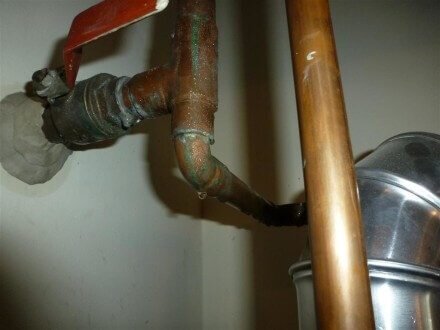
After a water heater has backdrafted for a while inside of a utility room, there will probably be heavy condensation on the cold water pipes. It’s typical to see condensation on cold water pipes during the summer, but a backdrafting water heater will make it dramatically worse.
Testing Draft
If you find these types of clues, the water heater might not draft properly. To test for proper water heater draft, do the following:
-
Turn down the heat at the furnace or boiler if there is a shared vent.
-
Close all windows and doors.
-
Close any fireplace dampers, if present.
-
Turn on any kitchen and bathroom exhaust fans.
-
Turn on the clothes dryer.
-
Run hot water at a bathtub or laundry sink long enough to get the water heater to turn on.
This creates a worst-case scenario for the water heater, but it should still draft properly under these conditions. Before testing the water heater draft, I let the burner run for a little bit; sometimes a water heater will initially backdraft for a minute or two, but will start drafting properly once the vent connector warms up enough.
Note: I’m using the term “worst-case scenario” loosely. A more accurate term would be “really bad scenario”. If you really want to create a worst-case scenario, check out Building Performance Institute’s standards for combustion appliance testing.
I have several different tools that I can use to check for the proper draft at a water heater if I’m feeling fancy, but there’s really no need. To check for proper draft, I simply cup my hands around the draft hood without actually touching it.
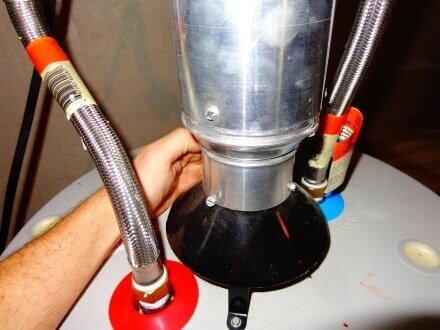
If the water heater is backdrafting, I’ll feel warm, moist air coming out of the draft hood. If I want visual evidence to put in an inspection report, I can hold a mirror up the draft hood and take a picture of the mirror getting fogged up. The photo below shows a mirror that happened to be sitting on top of a backdrafting water heater during an inspection; I had to take a photo of that, right?
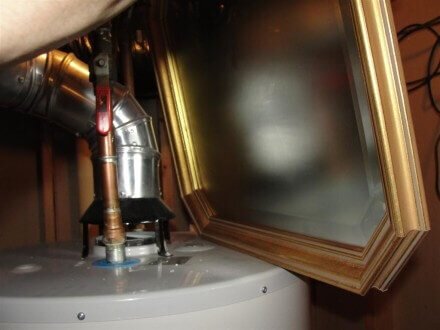
Another easy way to get visual evidence of a backdrafting water heater is to hold a camera close enough to the draft hood to allow the lens to get fogged up from the backdrafting flue gases. Powerful stuff, huh?
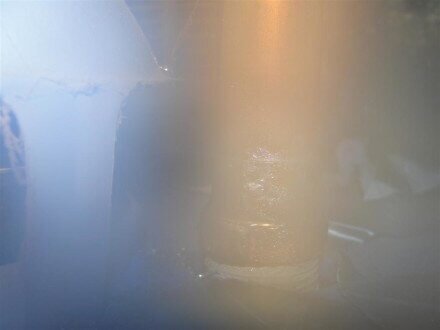
If there happen to be cobwebs hanging down from the draft hood, they can give a nice visual indication of backdrafting. The short video clip below shows a water heater backdrafting for about twenty seconds before the vent warms up. My camera lens even fogs over for a second when I get it too close to the draft hood. Don’t mind the friendly cats making noise in the background.
As I mentioned in the video at the beginning of this post, the repair for a backdrafting water heater isn’t always straightforward. If there is insufficient makeup air coming into the home, the fix is typically to have a combustion air duct installed. If the venting isn’t properly installed, that needs to be fixed. And if there’s an obstruction in the duct, that needs to be removed. Replacing a natural draft water heater with a powervent unit is the safest and surest way to address the problem, but it’s also the most expensive.
In next week’s blog post, I’ll cover the inspection of the water heater vent connector.
